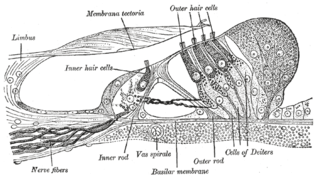Cutaneous mechanoreceptors
Cutaneous mechanoreceptors are physiologically classified with respect to conduction velocity, which is directly related to the diameter and myelination of the axon.
Rapidly adapting and slowly adapting mechanoreceptors
This section is missing information about four classes and what they are: SA1, SA2, RA1, RA2.(October 2021) |
Mechanoreceptors that possess a large diameter and high myelination are called low-threshold mechanoreceptors. Fibers that respond only to skin movement are termed rapidly adapting mechanoreceptors (RA), while those that respond also to static indentation are termed slowly adapting mechanoreceptors (SA). [1]
Aδ fibers
Aδ fibers are characterized by thin axons and thin myelin sheaths, and are either D-hair receptors or nociceptive neurons. Aδ fibers conduct at a rate of up to 25 m/s. D-hair receptors have large receptive fields and very low mechanical thresholds, and have been shown to be the most sensitive of known cutaneous mechanoreceptors. A-fiber mechanoreceptors (AM) also have thin myelination and are known for their "free" nerve endings. It is believed that A-fiber mechanonociceptors have high mechanical sensitivity and large receptive fields, and are responsible for rapid mechanical and heat pain.
C fibers
C fibers have slow conduction velocities of less than 1.3 m/s because they do not have a myelin sheath at all. C fibers account for 60-70% of primary afferent neurons that innervate the skin. C fibers are activated by both mechanical and thermal stimuli, and also respond to algesic chemicals, such as capsaicin. Some C fibers respond only to mechanical stimuli. Therefore, classification of C fibers are broken down further. C-fiber nociceptors which respond to both mechanical and thermal stimuli include C-mechanoheat (C-MH), C-mechanocold (C-MC), and C-mechanoheatcold (C-MHC). C-fiber nociceptors that respond only to mechanical stimuli are called C-mechanonociceptors (C-M). Other groups of C fibers include C-fiber low threshold mechanoreceptors (C-LT), which are involved in nondiscriminative touch, and mechanically insensitive afferents (MIA), which lack mechanosensitivity and are also known as "silent" or "sleeping" nociceptors. C fibers called "C-mechano insensitive heat insensitive" (C-MiHi) account for about 15-25% of all C fibers. [1]
Molecular mechanisms
Known molecular mechanisms of cutaneous mechanosensitivity are not completely understood. Most likely, a single unifying transduction process by which all sensory neurons function does not exist. It is believed, however, that sensory neurons employ fast, mechanically gated cation channels, and that the depolarization that results across the membrane is followed by the generation of a sodium-dependent action potential at the transduction site. It is believed that rapid, mechanically gated cation channels are characteristic of all sensory neurons. The membrane depolarization, in turn, leads to a sodium-dependent action potential at that location. It is also thought that mechanical strain is detected by ion channels through cytoplasmic and extracellular components. The existence of a distinct transduction process for all sensory neurons is highly unlikely. It has been hypothesized that the attachment of ion channels to cytoplasmic and extracellular structures is responsible for distinguishing mechanical strain on the cell membrane, and that cell curvature may not directly gate these ion channels alone. [1] Mechanosensation also contributes to cell growth and development through extracellular matrix (ECM) interaction and traction of integrin receptors which facilitate adhesion. [2]
TRP channels
The 'doctrine of specific nervous energies' states that particular nervous pathway activation causes various sensory modalities. Sensory receptor classification with respect to function suggest that different sensory modalities are governed by separate receptor classes. Transient receptor potential channels (TRP channels) (ion channels) introduce the idea that the expression of specific "molecular sensors" govern sensitivity to certain stimuli. Researchers believe that the ability of various somatosensory receptor neurons to respond to specific stimuli is a result of "combinational expression" of various ion channels in each specific neuronal class. Transduction channels work in their specific environment and should be treated as such. [3] TRP channels play a significant role in mechanosensation. There are seven TRP subfamilies: TRPC, TRPM, TRPV, TRPN, TRPA, TRPP, and TRPML. Some of these TRP channels respond to membrane lipid tension, including TRPY and TRPC1. Others respond directly to mechanical force, such as TRPN, TRPA1, and TRPV. Others are activated by a second messenger, such as TRPV4. [4] The TRPA subfamily plays a significant role in thermosensation. For example, TRPA1 is thought to respond to noxious cold and mechanosensation. [5] The cytoplasmic content of each of these differs significantly, leading researchers to doubt that the cytoplasm is the core of mechanosensation. [6]
Lipid bilayer
There is evidence that mechanosensitive channels may be in whole or in part governed by the lipid bilayer, which contributes to stretch forces which result in opening of the channel. [7] While it is known that the lipid bilayer properties of cell membranes contribute to mechanosensation, it is yet unknown to the extent the protein interacts with the head groups of the lipids. [8] The mechanosensitivity of TREK-1 channels in a biological membrane was directly attributed to the generation of phosphatidic acid in a fast two step process (<3 ms). [9] Activation was based on a model where lipid micro domains, within the lipid bilayer, partition signaling molecules into separate compartments and mechanical mixing of the signals leads to the production of phosphatidic acid and downstream signaling. [10]










